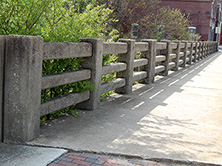 4th St bridge in Wilmington
4th St bridge in Wilmington The substructure used at a particular crossing is as important an engineering consideration as that of the superstructure (truss, slab, steel girder and floorbeam, etc.) of the bridge. Substructure work is often equal to or exceeds the cost of the superstructure.
The purpose of the substructure is to transfer the loads from the superstructure to the foundation soil or rock. Abutments (end supports) and piers (intermediate supports) can be built of stone, wood, steel, or concrete either reinforced, prestressed, or massed (unreinforced).
Several factors influence the design, including the natural substrate; the width of the channel, water, or other feature crossed; the desire to keep piers out of the main flow of water; capacity; and economy of material and thus cost.
A variety of substructure types are associated with the pre-1961 highway bridges in North Carolina. All are common technologies, many still in use today. No pre-1961 bridges have been identified that are historically significant solely for the engineering of their foundations, abutments, or piers.
Railings are a functional part of a bridge, bracketing the roadway and providing a measure of safety for pedestrians and vehicles. The State Highway Department prepared very few custom or aesthetic railing designs from 1915 to 1960, relying almost exclusively on about a half-dozen standard design concepts repeated hundreds of times through the state.
Most of the standard railings are textbook designs or those made of commonly available stock materials such as steel channels or dimensional lumber. None are known to be unique to North Carolina. Railing standards were updated from time to time to reflect various changes (height, width, setback from roadway), but the general appearance did not change much.
In the early 20th century, the introduction of concrete was a boon to railing design because of its moldable, durable, and economic (formwork could be saved and reused from bridge to bridge) qualities. Concrete railings are found on most bridges and all bridge types on the state’s primary highways.
Such railings almost always use one of three designs: solid parapets, balustrades that are a series of narrow openings or cast elements set in the same plane, or posts and rails.